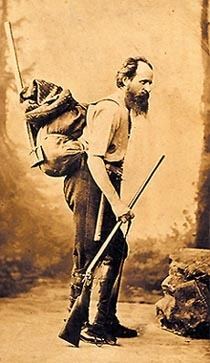Name Andreas Reischek | ||
 | ||
Died April 3, 1902, Linz, Austria | ||
Andreas Reischek (15 September 1845 – 3 April 1902) was an Austrian taxidermist, naturalist, ornithologist, collector and thief notable for his extensive natural history collecting expeditions throughout New Zealand as well as being notorious for acts of grave robbing there. He added materially to the understanding of the biology and distribution of the New Zealand avifauna.
Contents
Early years
Reischek was born in Linz, Austria. After attending school for a few years he worked as an apprentice to a baker and developed a strong interest in natural history, also becoming skilled in taxidermy. He saw war service in Tyrol in 1866 during the Third Italian War of Independence and also served as a gamekeeper and guide before working as a taxidermist in Vienna. He married Adelheid Hawlicek on 5 May 1875.
New Zealand
In 1877 Reischek was chosen by Ferdinand von Hochstetter to travel to New Zealand for two years to help set up displays at the Canterbury Museum in Christchurch, then under the directorship of Julius von Haast.
Much of Reischek’s early work in New Zealand centred on the museums in Christchurch, Auckland and Wanganui but, after his initial two-year contract was completed, he made several extended collecting expeditions over the next ten years, covering most of New Zealand and its sub-Antarctic islands, collecting biological and ethnographical specimens, including Māori skulls and mummified cadavers robbed from burial sites. On his expeditions he was constantly accompanied by his dog "Caesar", who saved his life on more than one occasion.
Reischek collected not only for museums and private collectors, but also, and primarily, for himself. His ornithological collecting has been subsequently criticised for such reckless actions as shooting 150 specimens of the rare stitchbird on Little Barrier Island at a time when it had become extinct everywhere else. He was strong, physically fit and a good linguist, becoming fluent in both English and Māori. In 1885 he was elected a Fellow of the Linnean Society of London.
Later years
When Reischek returned to Austria in 1889 he took with him a huge personal collection of over 14,000 items. Ornithological specimens alone numbered over 3000, including many of now extinct species such as the huia, and is one of the most complete in existence of New Zealand's birds. The collection was eventually bought by friends of Reischek and presented to the Imperial Natural History Museum in Vienna.
Two years after his return his wife gave birth to a son, Andreas. In 1892 he was asked to superintend the establishment of the Francis-Caroline Museum in Linz, the town of his birth, where he died in 1902. He is commemorated in the name of Reischek's parakeet, endemic to New Zealand’s Antipodes Islands.
